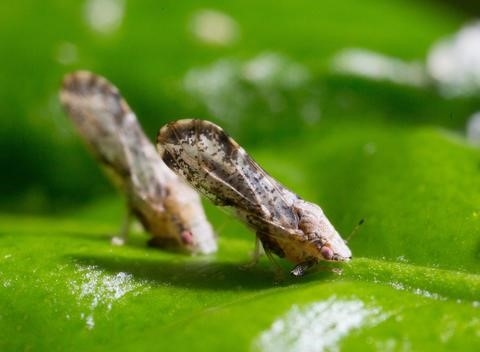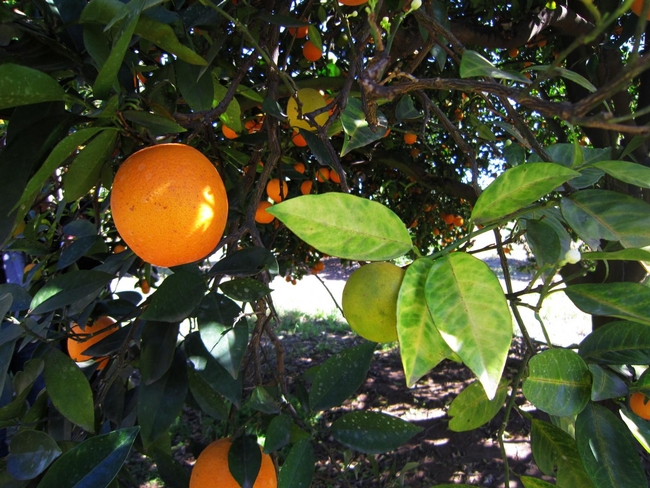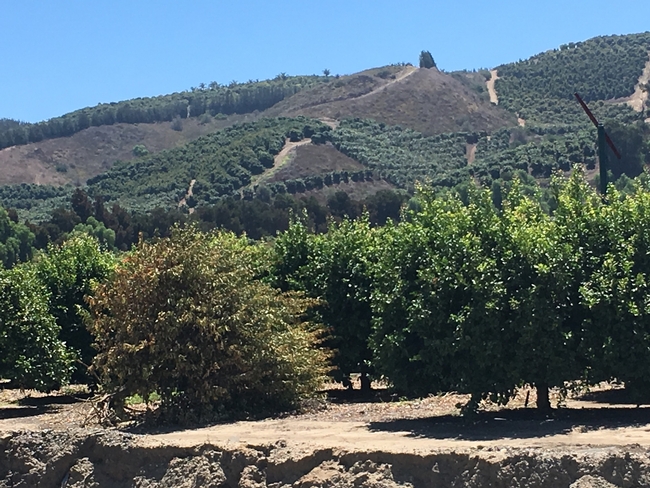UCR wages $11+ million war against citrus greening disease
Three projects win funding to fight tree-killing bacteria



Greening Bacterium Causes Changes in Psyllids
Recent studies, including a partnership project between Fundecitrus and the University of California, revealed that the citrus greening bacterium Candidatus Liberibacter asiaticus causes physiological changes in psyllids, posing additional challenges to management strategies. An increase in the number of eggs, more frequent dispersal flights over longer distances and greater attractiveness to the host are some of the changes observed in infected psyllids.
MORE DIFFICULT TO MANAGE
“Epidemiologically speaking, the changes we have been observing in psyllid behavior turn it into a much more problematic insect,” said Fernando Amaral, Fundecitrus agricultural engineer and post-doctoral student at the São Paulo University Luiz de Queiroz College of Agriculture.
The psyllid behavioral changes hinder the development of pheromone tools to attract the insect and improve its monitoring.
“It is becoming increasingly clear that the psyllid undergoes several changes, and this phenomenon not only poses difficulties to management, but also curbs the development of products to capture the insect,” added Fundecitrus researcher Haroldo Volpe.
Studies published between 2015 and 2024 revealed that psyllids infected with the greening bacteria can lay up to 100% more eggs than healthy insects, contributing to the growth of the psyllid population.
FREQUENT FLIERS
The studies also concluded that infected psyllids are more agitated when compared to healthy insects. In order to reach this conclusion, researchers placed adult insects from both groups on a platform. The teams noticed that infected insects flew, on average, after 50 seconds from the beginning of the observation period. The healthy subjects took around 150 seconds.
“Knowing that the insect flies more often and starts flying earlier demonstrates agitation and altered behavior, increasing its ability to spread greening,” said Volpe.
Yet another conclusion of the studies is that infected psyllids perform more frequent dispersal flights.
“Psyllids infected with the greening bacteria have a 45% higher rate of long flights when compared to healthy insects,” said Amaral.
In other words, the infected psyllid will fly longer distances and further spread the disease. Moreover, infected psyllids will also have a greater need to feed (forage) on more shoots and consequently will further disseminate the disease.
SUSCEPTIBILITY TO INSECTICIDES
On the other hand, the susceptibility of infected insects to insecticides is greater than that of healthy insects. Psyllids infected with the greening bacteria require a 20% to 313% lower concentration of insecticides to achieve the same mortality rate as healthy insects. This happens because the bacteria interferes with the psyllid metabolization of these products, which hinders their detoxication process.
CONTINUE COMBATING DISEASE
Fundecitrus General Manager Juliano Ayres emphasized the need for citrus growers to remain aware of the measures used to combat the disease in the field.
“The more diseased plants in groves without appropriate psyllid control, the more contaminated insects there will be and, consequently, the faster the disease will spread,” Ayres said. “Therefore, it is essential to continue to eliminate diseased plants from groves and keep up strict control of the insect on these plants.”
Source: Citricultor, Fundecitrus
CLas-Positive Psyllid Sample in Riverside County
July 26, 2024
An adult Asian citrus psyllid (ACP) sample from a residential property in the San Jacinto Valley area of Riverside County, California, has tested positive for Candidatus Liberibacter asiaticus (CLas), the bacterium that causes huanglongbing (HLB).
The positive sample was collected as part of the Multi-Pest Risk Survey on a residential property in Hemet. It was confirmed positive for CLas on July 17 by the Citrus Research Board's Jerry Dimitman Laboratory. Nymphs were also collected from the property and tested negative for CLas. This is the first confirmed CLas-positive adult ACP found in the San Jacinto Valley area.
An HLB quarantine zone will not be established as a result of this CLas-positive ACP detection. However, California Department of Food and Agriculture (CDFA) staff is conducting surveys and collecting samples from the property and all HLB host plants that are located within a 250-meter radius around the find, per the ACP/HLB Action Plan.
It is crucial that ACP populations continue to be controlled properly in order to stop HLB from spreading, advised California's Citrus Pest & Disease Prevention Program.
While CDFA is not requiring mandatory treatment for area commercial growers, those who wish to take proactive steps to protect their groves or who have additional questions can contact Riverside County Grower Liaison Sandra Zwaal.
In September 2023, a CLas-positive ACP sample was collected from a residential property in California's Ventura County. That sample came from a residential citrus tree in the southwest area of Santa Paula. An HLB quarantine zone was not established as a result of that detection, either. While that first confirmation of a CLas-positive ACP in Ventura County was concerning, HLB was not detected in any Ventura County citrus trees. Learn more here.
Source: Citrus Pest & Disease Prevention Program

acp lewis
Ah, summer! The season of sunburns, pool parties, and… lawn droughts. If your once lush, green carpet now looks like a crunchy brown doormat, you're not alone. Let's dive into why your yard is staging a dramatic death scene and what you can do to...

Bermuda grass and weeds overtaking drought stressed turf grass.
Cultivating Citrus Resilience to HLB in California
Ashraf El-Kereamy
Cooperative Extension Specialist at UCR
Director of UC Lindcove Research and Extension Center
Huanglongbing (HLB), also known as citrus greening disease, is caused by the bacterium Candidatus Liberibacter asiaticus, which is transmitted by the Asian citrus psyllid. The bacterium harms citrus trees in several ways, leading to severe physiological and structural damage.
After the infection, the HLB bacterium invades the phloem, the vascular tissue responsible for transporting nutrients throughout the tree. HLB causes a disruption in nutrient uptake and transport within the tree. This leads to nutrient deficiencies, particularly in essential elements such as nitrogen, phosphorus, and potassium. As a result, the tree experiences stunted growth, yellowing of leaves (chlorosis), and overall nutrient imbalance. The bacterium affects the root system, leading to root loss and dieback. This compromises the tree's ability to take up water and nutrients from the soil, exacerbating the impact of nutrient deficiencies and water stress. Additionally, it affects the photosynthetic process in citrus trees. The bacterium's presence disrupts chloroplast function, reducing the tree's ability to convert sunlight into energy. This results in decreased photosynthesis, further contributing to nutrient deficiencies and overall tree decline. One of the characteristic symptoms of HLB is the yellowing of leaves, often referred to as citrus greening. The bacterium affects the chlorophyll content in leaves, leading to a mottled appearance. This yellowing occurs unevenly on the tree and is a clear indicator of HLB infection. HLB-infected trees experience stunted growth due to the disruption of normal physiological processes. The overall health of the tree declines, leading to a reduction in fruit production and quality. Infected trees may produce smaller, misshapen, and discolored fruit. HLB-infected trees often exhibit premature fruit drop, where fruit drops from the tree before reaching maturity. This is a significant economic impact for citrus growers, as it reduces the yield and marketable fruit. Over time, HLB-infected trees undergo a general decline in health. The combination of nutrient deficiencies, reduced photosynthesis, and compromised vascular function can lead to the death of the tree. The lifespan of infected trees is significantly shortened compared to healthy trees.
It's important to note that there is currently no cure for HLB, and managing the disease involves a combination of strategies. While researchers from all over the world are working hard to get a cure for that disease, citrus growers are increasingly turning to cultural practices (a diverse set of agricultural strategies) as a sustainable and holistic approach to mitigate the profound impact of this relentless disease. Cultural practices encompass a nuanced and multifaceted array of agricultural techniques and approaches used in citrus groves. In the realm of citrus and HLB management, a comprehensive strategy is imperative to create an environment that not only minimizes the likelihood of disease transmission but also nurtures the robustness of citrus trees and makes them more resilient to HLB.
Various agencies in California are making significant efforts on Psyllid monitoring and management, a first defense line to stop the spread of the disease. Regular Monitoring: Instituting a meticulous and frequent monitoring system for Asian citrus psyllid populations is paramount. This proactive approach enables growers to detect infestations early, facilitating targeted interventions to halt the spread of HLB. In addition to Psyllid monitoring and management, harnessing the power of nature through the introduction of beneficial insects establishes a delicate ecological balance. These natural predators act as biological control agents, keeping psyllid populations in check without resorting to chemical pesticides. Swift identification and removal of HLB-infected trees are critical components of disease management. The prompt destruction of infected trees eliminates potential bacterium reservoirs, mitigating the risk of further psyllid transmission to healthy trees. Utilizing beneficial microorganisms as soil inoculants enhances root health and improves nutrient uptake, potentially bolstering the tree's ability to withstand HLB stress.
Another method is to isolate the trees from the Psyllid through growing the Citrus trees Under Protective Screen (CUPS). The system is a closed screenhouse built on a number of acres from 1-5 acres. The system is currently used by some growers in Florida; however, the response of the Californian varieties to grow under such conditions is not known. The first CUPS structure was established at UC Lindcove research and extension center, and we are currently evaluating the performance of some varieties under this structure.
Recognizing that weeds can serve as alternative hosts for psyllids, implementing rigorous weed management practices eradicates potential habitats and minimizes the presence of psyllids in citrus groves. Studies in Florida and California showed a beneficial effect of using wood chip mulching on root growth and weed control. We are collecting more data on these trials, and it will be available for the growers during the next season.
Managing nutrients with precision is vital for supporting citrus tree health. Tailoring fertilization to the unique needs of the orchard ensures trees receive optimal amounts of essential nutrients like nitrogen, phosphorus, and potassium. This fortification enhances natural defenses against HLB. Additionally, implementing consistent and well-timed irrigation practices is crucial. Effective water management alleviates stress on citrus trees, reducing susceptibility to HLB and other stress-related diseases.
Further, incorporating HLB-resistant rootstocks is a crucial aspect of disease management. Selecting rootstocks that exhibit resistance or tolerance to the bacterium contributes significantly to orchard health. Ongoing research endeavors focus on identifying citrus varieties that exhibit inherent resistance or tolerance to HLB. The strategic planting of these varieties adds an extra layer of protection against the disease and its associated symptoms, contributing to the overall health and productivity of citrus orchards. Currently, we are evaluating the effect of a number of HLB resistant rootstocks on the tango mandarin growing under California conditions. These rootstocks include US942, US897, and X639. The evaluation of the resistant rootstock and varieties will continue in collaboration with worldwide researchers.
In the face of the formidable challenge presented by HLB disease, cultural practices emerge as a promising, sustainable, and sophisticated approach to mitigation. By embracing a comprehensive strategy that intertwines vigilant psyllid management, optimization of tree health, meticulous sanitation measures, selective varietal planting, and collaborative initiatives, citrus growers can fortify the resilience of their orchards. The integration of cultural practices, including rootstock selection and proper fertilization, not only contributes to HLB control but also nurtures the long-term sustainability of citrus farming, ensuring a future where citrus crops not only survive but thrive in the face of adversity. As our understanding of cultural practices evolves, the citrus industry can anticipate a resilient, vibrant, and flourishing future.

hlb infection
International Research Conference on HLB
Here in California
The International Research Conference on Huanglongbing VII (IRCHLB VII) is just around the corner! The California citrus industry is excited to welcome researchers, regulators, and citrus industry members from around the world to the Golden State. Do not miss these key dates:
A hotel room block with special conference rates has been set aside near the convention center and is filling up quickly. Book your room today at the Historic Mission Inn Hotel & Spa.
For the conference agenda, please click here. To register and access more conference details, CLICK HERE..
This Conference has occurred every two years (except for the covid period). Check out the Proceedings from previous conferences!
The proceedings of the “International Research Conference on Huanglongbing” are available from the 2008, 2011, 2013, 2015, 2017, and 2019 conferences. Please use the following hyperlinks to access the proceedings.

IRCHLB 2023
With three new grants totaling more than $11 million, UC Riverside is helping lead the fight against citrus greening or Huanglongbing, a disease threatening citrus industries in the U.S. and worldwide.
The disease is from bacteria transmitted to citrus trees by a tiny flying insect, the Asian citrus psyllid. Infected trees produce no fruit, or fruit that is bitter, small and worthless. Despite intensive research for the past 15 years, there is no known cure for it. It has reduced citrus production in Florida by more than 75%, and it has already been detected in Texas and California.
Because California supplies the country with 80% of its fresh citrus, and because 267,000 acres of Golden State lemons, oranges, grapefruits, and mandarins are at stake if operations are permanently lost, the USDA National Institute of Food and Agriculture is making an emergency investment in citrus disease research with three projects at UCR.
These projects focus on instilling tolerance to the disease with three different approaches: below ground, in the rootstocks, above ground in the shoots and branches, and systemically, with a peptide that would move throughout the tree.
The largest of the projects, at $6.8 million, is being led by Danelle Seymour, assistant professor of genetics in the Botany and Plant Sciences Department at UCR. Their focus is on breeding Huanglongbing or HLB-resistant rootstocks, and the project depends on collaboration with Kim Bowman, a citrus breeder at the USDA Agricultural Research Service in Ft. Pierce, Florida.
“In Florida, nearly every single tree is infected. It's terrible for growers, but wonderful for breeding,” Seymour said. “We can't do this research at large scale in California because the disease isn't as widespread here.”
The classic way to improve resistance or encourage new qualities in crops is through genetics, making crosses between one plant that has a favorable trait, and one that doesn't. “We hope the result is better than the parents,” Seymour said. “When you work in wheat or tomato, you can do these crosses and perform evaluations every year. In citrus, it takes 10 - 15 years to evaluate a new generation of trees.”
Because of the long lag time, the research-ready trees in Florida represent an opportunity for Seymour's team to begin examining new crosses now. The breeder, Kim Bowman, has evaluated over 10,000 trees and unique hybrids, from which a handful will be selected for release to growers.
In addition to evaluating these select few new hybrids for their HLB tolerance, the researchers will be watching the Florida-grown trees' responses to the different environmental conditions in California. “Can they perform well in response to different salinity levels in the soil, different humidity, as well as other pests and pathogens that we have here? We'll find out,” Seymour said.
Chandrika Ramadugu, a project scientist also in UCR's Department of Botany and Plant Sciences, is leading a project to develop HLB-resistant scion varieties that can be grafted to rootstocks. A scion is an above-ground portion of a plant, such as a bud or shoot, that can be used for grafting.
For trees, grafting can be equated to an organ transplant. The scion from one tree is attached to the trunk or rootstock of another with the hope of creating a new plant with combined attributes.
With its grant of $3.28 million, this project will analyze second-generation hybrids that are bred for ten years using Australian lime as a source of disease resistance.
Ramadugu will evaluate 24 novel hybrids in California, Florida, and Texas to assess resistance to HLB. Ideally, in addition to having enhanced disease tolerance, the new plants will also be able to produce good-tasting fruit.
There is little genetic diversity in cultivated citrus. When new pathogens arrive, the genetic uniformity can result in disease epidemics and dire consequences for the crop. In addition to the potential benefits of this project for the fight against HLB, the new hybrids may also help protect citrus from other pests and pathogens.
A third project, granted $1.36 million, will utilize a peptide found in Australian finger limes that is known to impart HLB resistance. Led by Hailing Jin, Microbiology & Plant Pathology professor, the project is developing ways to infuse trees with the peptide.
“The antimicrobial peptide in the finger limes are more efficient at killing bacteria as compared to antibiotics currently used in the field, and much more stable at high temperatures,” Jin said.
Because spray applications are expensive, Jin's project aims to spread the peptide throughout the trees' insides. In collaboration with University of Florida professor Svetlana Folimonova, Jin's team utilizes a natural citrus virus with almost no symptoms to deliver the peptide into the trees.
“You infect the tree with the virus, and it will spread in areas where the bacteria reside,” Jin said. “It would move systemically through the tree, and it would be very cost efficient for growers. No need to buy more insecticides.”
These grants were enabled by the 2018 Agricultural Improvement Act, which authorized the Emergency Citrus Disease Research and Development Trust Fund to fight HLB. With these and other projects, the USDA is bringing together the nation's top scientists to find scientifically sound solutions to the problem in a financially and ecologically sustainable way.

hlb tree pulled